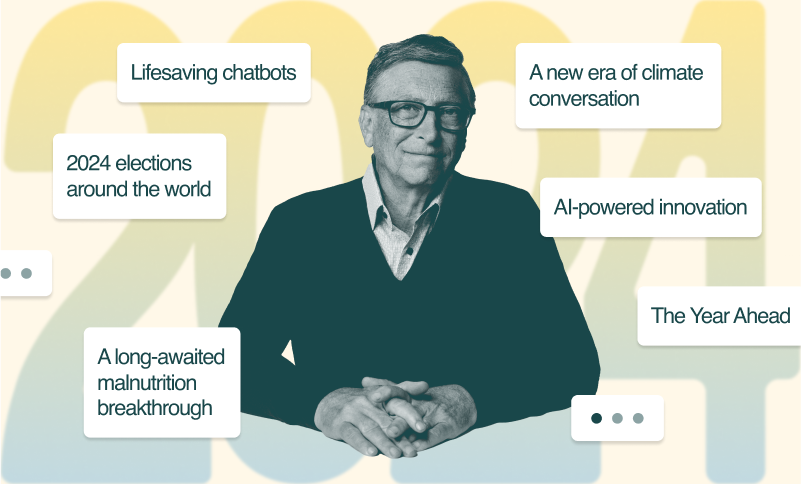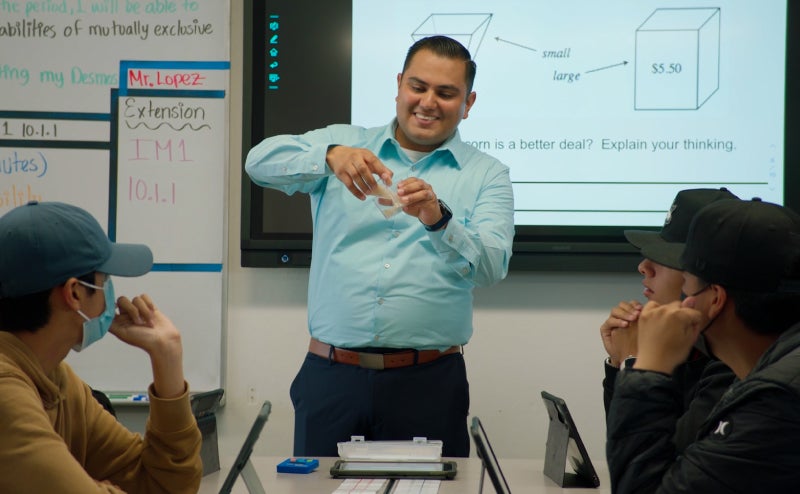I was honored to be one of the speakers at the Leaders Summit on Climate hosted by President Biden.
Melinda and I got involved in U.S. education in 2000. A lot has changed since then, but our goal has not: We still want all children in America to get a great education. It’s key to realizing the vision of America as a country where all people have a chance to make the most of their talents.
Based on everything we have learned in the past 17 years, we are evolving our education strategy. I explained what’s changing in a speech today at the Council of the Great City Schools. Here’s the text of my speech:
Remarks as prepared
The Council of Great City Schools
Cleveland, OH
October 19, 2017
When our foundation began working in education in 2000, we started with a few guiding principles.
Our #1 priority was – and still is – ensuring that all students get a great public education and graduate with the skills to succeed in the workplace.
We wanted to work with educators to better understand their needs and the needs of their students and communities.
And, taking their best ideas, we wanted to pilot potentially transformative solutions and understand what worked well and what didn’t.
Today, I’d like to share what we have learned over the last 17 years and how those insights will change what we focus on over the next five years.
But first, I’d like to say a few words about the state of public education in the U.S. By and large, schools are still falling short on the key metrics of a quality education – math scores, English scores, international comparisons, and college completion.
While much has rightly been made of the OECD data that shows lagging performance of American students overall, the national averages mask a bigger story.
When disaggregated by race, we see two Americas. One where white students perform along the lines of the best in the world—with achievement comparable to countries like Finland and Korea. And another America, where Black and Latino students perform comparably to the students in the lowest performing OECD countries, such as Chile and Greece.
And for all students in U.S. public schools, the percentage of high school graduates who enroll in postsecondary institutions has remained essentially flat.
Without success in college or career preparation programs, students will have limited economic mobility and fewer opportunities throughout their lives. This threatens not only their economic future but the economic future and competitiveness of the United States.
There are some signs of progress. Over the past decade, in cities like Charlotte, Austin, and Fresno, high school graduation rates have gone up rapidly.
Fourth-grade reading and math scores in large city schools increased at almost double the rate of public schools nationally. And the 8th grade scores are even better.
But like many of you, we want to see faster and lasting change in student achievement – and our commitment to that goal is steadfast. In fact, given the constraints and other demands on state and local budgets, it’s more important than ever that we continue to explore the best ideas for improving student achievement.
Melinda and I made public education our top priority in the U.S. because we wanted to do something about the disparity in achievement and postsecondary success for students of color and low-income students. That inequity persists today, and we are just as determined now to eliminate it as we were when we started.
When we first got involved in U.S. education, we thought smaller schools were the way to increase high school graduation and college-readiness rates. In some places and in some ways, small schools worked.
In New York City, graduation rates of students attending small schools was more than 30 percentage points higher than the schools they replaced. And almost half of the students attending small schools enrolled in postsecondary education – a more than 20 percent difference from schools with similar demographics.
Results in other places – like Los Angeles and the Rio Grande Valley in Texas –were also encouraging. Yet, over time, we saw that the overall impact of this strategy was limited—the financial and political costs of closing existing schools and replacing them with new schools was too high.
Over time, we realized that what made the most successful schools successful – large or small – was their teachers, their relationships with students, and their high expectations of student achievement.
Understanding this, we saw an opportunity to move our work closer to the classroom – to systemically support schools across the country to improve the quality of teaching and raise academic standards.
In 2007, we began investing in the Measures of Effective Teaching project. Over the last decade, it has contributed important knowledge to the field about how to gather feedback from students on their engagement and classroom learning experiences . . . and about observing teachers at their craft, assessing their performance fairly, and providing actionable feedback.
This work has helped states across the country build comprehensive evaluation systems based on multiple measures. We’ve seen promising results in places like Cincinnati, Chicago, New York City, and Washington DC, where research shows these systems can help identify teachers who need to improve and those who are underperforming . . . and in places like Tennessee, where three out of four teachers say the evaluation process improves their teaching.
But districts and states have varied in how they have implemented these systems because they each operate in their local context.
In addition, it became clear that teacher evaluation is one important piece of several critical elements to drive student achievement. School leadership, teacher professional development, climate, and curriculum also play critical roles in improving student achievement.
As you know, we also backed the Common Core because we believed, and still believe, that all students – no matter where they go to school – should graduate with the skills and knowledge to succeed after high school. It’s exciting to see how the standards are being brought to life in schools and classrooms. But more needs to be done to fully realize their potential.
As we have reflected on our work and spoken with educators over the last few years, we have identified a few key insights that will shape our work and investments going forward.
Teachers need better curricula and professional development aligned with the Common Core. And we see that they benefit the most from professional development when they are working with colleagues to tackle the real problems confronting their students.
Schools that track indicators of student progress — like test scores, attendance, suspensions, and grades and credit accumulation – improved high school graduation and college success rates.
And last, schools are the unit of change in the effort to increase student achievement and they face common challenges – like inadequate curricular systems and insufficient support for students as they move between middle school, high school and college. And they need better strategies to develop students’ social and emotional skills. But solutions to these problems will only endure if they are aligned with the unique needs of each student and the district’s broader strategy for change.
So, what does this mean for our work with you and others?
First, although we will no longer invest directly in new initiatives based on teacher evaluations and ratings, we will continue to gather data on the impact of these systems and encourage the use of these systems to improve instruction at the local level.
Second, we will focus on locally-driven solutions identified by networks of schools, and support their efforts to use data-driven continuous learning and evidence-based interventions to improve student achievement.
Third, we are increasing our commitment to develop curricula and professional development aligned to state standards.
Fourth, we will continue to support the development of high-quality charter schools.
There is some great learning coming from charters, but because there is other philanthropic money going to them, we will focus more of our work with charters on developing new tools and strategies for students with special needs.
Finally, we will expand investments in innovative research to accelerate progress for underserved students.
Overall, we expect to invest close to $1.7 billion in U.S. public education over the next five years.
We anticipate that about 60 percent of this will eventually support the development of new curricula and networks of schools that work together to identify local problems and solutions . . . and use data to drive continuous improvement.
Many states, districts, and schools now have the data they need to track student progress and achievement, and some are using it to great effect.
In Fresno, a new data system revealed that students weren’t aware of their college options. So, the district created individualized college information packets for every senior who met the state’s college requirements. The result was a 50 percent increase in the number of students applying to California public universities.
Summit Public Schools, which operates 11 charter schools in California and Washington, analyzed data and determined that English Learners entered school significantly behind and never caught up.
So, it identified the teachers whose EL students were doing the best, talked to them and curated their materials, and applied those best practices across all Summit schools. In less than a year, the performance gap between English Learners and others decreased by 25 percent.
In Chicago, researchers also found powerful insights in their data that are predictive of student progress and success. They determined, for example, that 9th graders who succeed on four key indicators – high attendance, course completion rates, credit accumulation, and grades – are more than four times as likely to graduate. And if their grades are a B+ or higher, they are much more likely to succeed in their first year of college.
Excited by insights like these, school leaders in Chicago partnered with the University of Chicago to create the Network for College Success.
This network of schools is using data to identify strategies that educators can use to solve specific problems. From 2007 to 2015, the percentage of students on track to graduate from Chicago high schools rose from 61 to 85 percent. And four-year college enrollment rates in Chicago went from 36 to 44 percent.
We believe this kind of approach – where groups of schools have the flexibility to propose the set of approaches they want – will lead to more impactful and durable systemic change that is attractive enough to be widely adopted by other schools.
We are seeing more examples of this popping up all the time. Like the CORE Districts in California – comprised of eight of the largest school districts in the state. And the LIFT Network in Tennessee, which includes educators from 12 rural and urban districts across the state.
Over the next several years, we will support about 30 of these networks, and will start initially with high needs schools and districts in 6 to 8 states. Each network will be backed by a team of education experts skilled in continuous improvement, coaching, and data collection and analysis.
There are two things these networks will share in common. A commitment to continuous improvement. And a focus on addressing common problems that are identified by using proven indicators predictive of students’ learning, progress, and postsecondary success.
But we will leave it up to each network to decide what approaches they believe will work best to address their biggest challenges. They might decide, for example, to focus on student interventions in middle school . . . or adapting new and more rigorous curricula . . . or improving support for certain groups of students in the transition from high school to college.
We will work with partners to document these change efforts in schools and networks and ask them to share the lessons learned with others.
We’ll also work with teacher and leader prep providers to ensure that these lessons and best practices are incorporated into local programs to further enrich and sustain this work.
We also know that high-quality curricula can improve student learning more than many costlier solutions, and it has the greatest impact with students of novice and lower performing teachers. We also know it has the greatest impact when accompanied by professional learning and coaching.
Our goal is to work with the field to ensure that five years from now, teachers at every grade level in secondary schools have access to high-quality, aligned curriculum choices in English and math, as well as science curricula based on the Next Generation Science Standards. In a few places, we also will support pilots of scalable professional development supports anchored in high quality curriculum.
Louisiana is a great example of where aligned curricula and professional development is helping teachers. 80 percent of districts have adopted fully aligned curricula in grades 3 through 8. And the state has created a marketplace of preferred professional development service providers to help schools implement these curricula effectively. Teachers report that they feel more equipped to help students meet the standards—for example, by closely reading texts for meaning.
In Washington DC, the school district has developed an innovative professional development program that is discipline-specific, curricula-aligned, and focused on improving teachers’ instructional skills at the school level. Teachers meet weekly with a coach who is an expert in the subjects they teach. They also meet in small groups with colleagues who teach the same subject to talk through lesson plans, what’s working, and how to adjust their instruction accordingly. While still early, 87 percent of teachers say the collaboration and feedback is improving their practice and knowledge.
We expect that about 25 percent of our funding in the next five years will focus on big bets – innovations with the potential to change the trajectory of public education over the next 10 to 15 years.
The conditions for developing and spreading new approaches in education, particularly technology-enabled ones, are better than ever. Broadband access in schools is reaching 90 percent. Students and teachers have access to more affordable and more powerful tools for learning. Educators are seeking each other out and sharing ideas in digital communities. And there are promising developments in neuroscience, cognitive psychology, and behavioral economics.
But the PreK-12 research, development and translation ecosystem is underfunded and fragmented, with less than 1 percent of total government spending in public education focused on R&D.
Math is one area where we want to generate stronger evidence about what works. What would it take, for example, to get all kids to mastery of Algebra I? What kinds of intelligent tools do teachers and students need to get there? And how might we design these in partnership with the best math teachers in the country?
We are also interested in what role we can play to prepare students for the dramatic changes underway in the workforce. We have to make work-related experiences a consistent part of high schools in ways that build student engagement and relevant skills, and that put young people on a path to credentials with labor market value in our future economy.
We anticipate that the final 15 percent of our funding in the next five years will go to the charter sector.
We will continue to help high-performing charters expand to serve more students. But our emphasis will be on efforts that improve outcomes for special needs students – especially kids with mild-to-moderate learning and behavioral disabilities. This is a critical problem across the education sector, and we believe that charters have the flexibility to help the field solve this problem.
Over the last 17 years, we have invested $1 billion in the cities represented in the room in support of school improvement and redesign efforts. We are proud of that work and have seen some good things come out of it that make me optimistic about the future.
Education is, without a doubt, one of the most challenging areas we invest in as a foundation. But I’m excited about the shift in our work and the focus on partnering with networks of schools.
Giving schools and districts more flexibility is more likely to lead to solutions that fit the needs of local communities and are potentially replicable elsewhere.
I’m also hopeful this will attract other funders focused on particular approaches or who work in one state or community.
If there is one thing I have learned, it is that no matter how enthusiastic we might be about one approach or another, the decision to go from pilot to wide-scale usage is ultimately and always something that has to be decided by you and others the field.
Our role is to serve as a catalyst of good ideas, driven by the same guiding principle we started with: all students – but especially low-income students and students of color – must have equal access to a great public education that prepares them for adulthood. We will not stop until this has been achieved, and we look forward to continued partnership with you in this work in the years to come.
Thank you.





